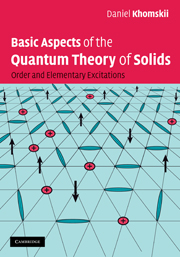Book contents
- Frontmatter
- Contents
- Foreword and general introduction
- 1 Some basic notions of classical and quantum statistical physics
- 2 General theory of phase transitions
- 3 Bose and Fermi statistics
- 4 Phonons in crystals
- 5 General Bose systems; Bose condensation
- 6 Magnetism
- 7 Electrons in metals
- 8 Interacting electrons. Green functions and Feynman diagrams (methods of field theory in many-particle physics)
- 9 Electrons with Coulomb interaction
- 10 Fermi-liquid theory and its possible generalizations
- 11 Instabilities and phase transitions in electronic systems
- 12 Strongly correlated electrons
- 13 Magnetic impurities in metals, Kondo effect, heavy fermions and mixed valence
- Bibliography
- Index
Foreword and general introduction
Published online by Cambridge University Press: 05 June 2012
- Frontmatter
- Contents
- Foreword and general introduction
- 1 Some basic notions of classical and quantum statistical physics
- 2 General theory of phase transitions
- 3 Bose and Fermi statistics
- 4 Phonons in crystals
- 5 General Bose systems; Bose condensation
- 6 Magnetism
- 7 Electrons in metals
- 8 Interacting electrons. Green functions and Feynman diagrams (methods of field theory in many-particle physics)
- 9 Electrons with Coulomb interaction
- 10 Fermi-liquid theory and its possible generalizations
- 11 Instabilities and phase transitions in electronic systems
- 12 Strongly correlated electrons
- 13 Magnetic impurities in metals, Kondo effect, heavy fermions and mixed valence
- Bibliography
- Index
Summary
Foreword
There are many good books describing the foundations and basics of solid state physics, such as Introduction to Solid State Physics by C. Kittel (2004) or, on a somewhat higher level, Solid State Physics by N. W. Ashcroft and N. D. Mermin (1976). However there is a definite lack of books of a more advanced level which would describe the modern problems of solid state physics (including some theoretical methods) on a level accessible for an average graduate student or a young research worker, including experimentalists.
Usually there exists a rather wide gap between such books written for theoreticians and those for a wider audience. As a result many notions which are widely used nowadays andwhich determine ‘the face’ of modern solid state physics remain ‘hidden’ and are not even mentioned in the available literature for non-specialists.
The aim of the present book is to try to fill this gap by describing the basic notions of present-day condensed matter physics in a way understandable for an average physicist who is going to specialize in both experimental and theoretical solid state physics, and more generally for everyone who is going to be introduced to the exciting world of modern condensed matter physics – a subject very much alive and constantly producing new surprises.
In writing this book I tried to follow a unifying concept throughout. This concept, which is explained in more detail below, may be formulated as the connection between an order in a system and elementary excitations in it.
- Type
- Chapter
- Information
- Basic Aspects of the Quantum Theory of SolidsOrder and Elementary Excitations, pp. ix - xivPublisher: Cambridge University PressPrint publication year: 2010



